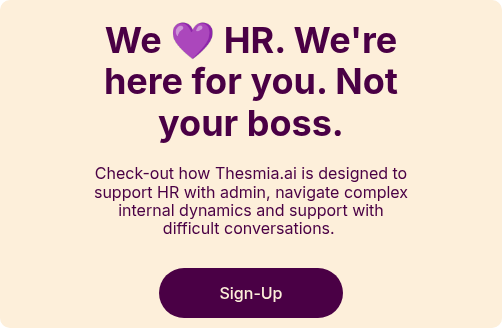How to prompt AI like a pro: A guide for HR people
 By
Emma Davies
·
2 minute read
By
Emma Davies
·
2 minute read
AI is only as good as the person prompting it.
And for HR, that really matters, because when you’re dealing with people, culture and communication, context is everything.
Most generic AI tools can churn out text. But they don’t understand your world, the politics of getting senior buy-in, the tightrope of manager engagement, or the frustration of employees ignoring your carefully written messages.
That’s why learning how to prompt like a pro is your secret advantage, and where tools like Thesmia.ai come in.
Step 1: Start with Purpose, Not Tasks
Bad prompts start with:
“Write me an email about performance reviews.”
Good prompts start with:
“Help me write an email for managers to introduce a new performance review process that makes them feel supported, not overloaded.”
See the difference? The second gives context, audience, and intention. AI can’t guess those things, you have to feed them in.
Pro tip: Always include
-
Who you’re speaking to (leaders, managers, employees)
-
The purpose (to align, inform, motivate, or get feedback)
-
The tone you need (credible, calm, motivating, human)
Step 2: Give Context Like You’d Brief a Colleague
AI isn’t magic, it’s a mirror of what you tell it.
So when you’re prompting, pretend you’re briefing a comms partner:
Tell it the background, the challenges, the blockers, and what success looks like.
Example:
“Our managers are feeling change fatigue after a busy quarter. I need a comms plan that explains the ‘why’ behind this new wellbeing programme without adding noise.”
That single sentence helps AI create something strategic — not just a message, but a moment that lands.
Step 3: Think Channels, Not Just Content
AI can write, but it can also help you plan.
The best prompts include what channels you use, email, Slack, all-hands, one-to-ones, so it can suggest where and when to communicate.
Example:
“Can you build a 4-week rollout plan using Slack and email, with ideas for video updates from our CEO and polls for quick feedback?”
This kind of multi-channel thinking is what turns comms into campaigns.
Step 4: Use AI to Make You Strategic, Not Robotic
The goal isn’t to replace HR. It’s to give you headspace.
AI should help you see the patterns: what messages are landing, what needs sequencing, what blockers need influence rather than repetition.
That’s where Thesmia.ai makes all the difference.
It’s not just another chatbot, it’s an AI Internal Comms partner trained in HR, marketing, and change management. It already knows how to:
-
Write messages that reflect HR tone and best practice
-
Create rollout timelines and comms plans
-
Build stakeholder decks that show ROI
-
Draft content for managers and employees that actually gets read
So instead of wrestling with generic AI, you get tailored strategic support built for your world.
Step 5: Keep Your Voice
AI can help you write faster, but your culture, empathy and leadership voice are what make it yours.
Always review, refine, and humanise before sending. The best AI output still needs your heart, your judgment, and your sense of timing.
In Summary
Prompting like a pro isn’t about knowing the perfect syntax, it’s about knowing your intention.
When you combine that with a tool like Thesmia, built specifically for HR, change and communication, you unlock what AI was meant to do:
make you faster, clearer, and more strategic, without losing the human touch.
Because the best prompts don’t just get answers, they get action.



